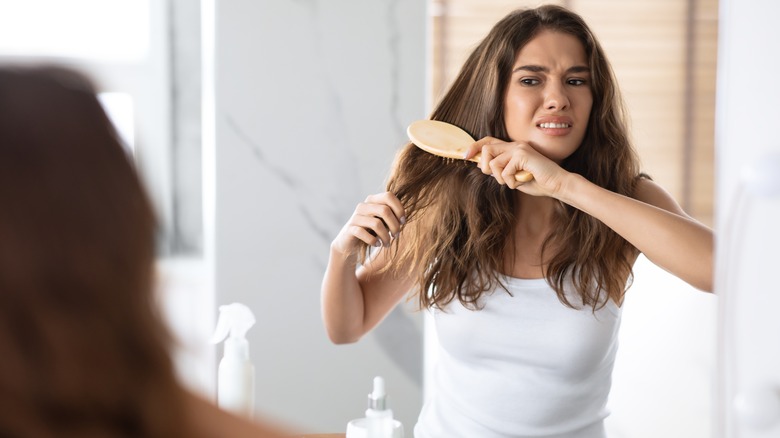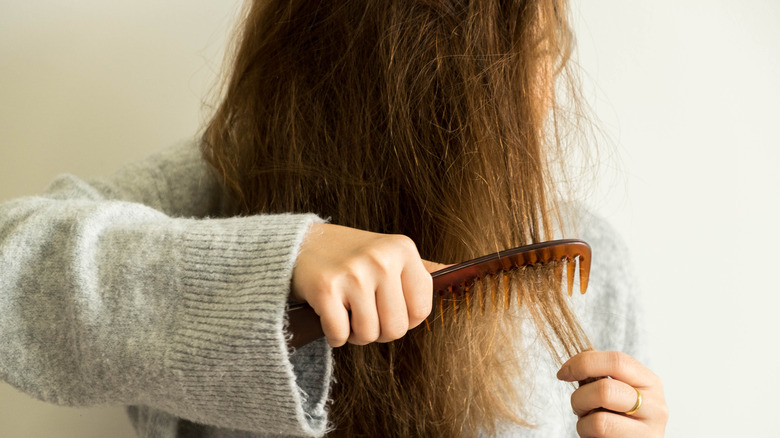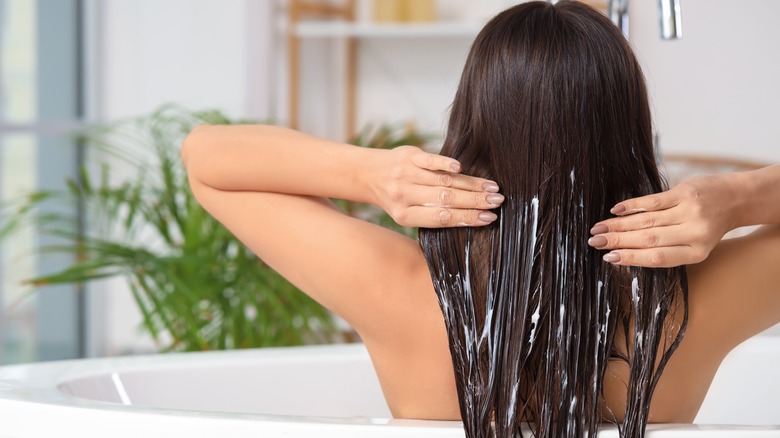If Your Hair Is Getting Extra Tangled, It May Be More Serious Than You Think
If you've ever walked along the beach on a windy day, you'll understand the joys of trying to comb tangled hair. But while knotted strands are to be expected in certain situations — like a windy beach — frequent or recurring tangled hair can be a sign of a problem. According to trichologist Penny James of the Penny James Trichology Center, excessively tangled hair can point to damage.
"The hair is comprised of keratin fibers that can break down with wear and tear to the hair,' James explains in an exclusive conversation with Glam. She adds that "over-bleaching and the use of heated styling tools" can contribute to the breakdown of these fibers, which then leads to tangling. That said, extreme tangling isn't always a form of damage. "If you have very fine hair texture, this hair type is prone to tangle easily," James confirms. Bleached hair is also more likely to tangle from the mid-lengths to the ends. But if you don't have fine or bleached hair (the latter of which often can lead to damage) and you're constantly dealing with knots that just won't go away, it's possible that your hair health is compromised.
The relationship between hair damage and tangles
Penny James explains that the relationship between hair damage and tangles is due to the impairment of the cuticles. "The outer layer of the hair has cuticles," she tells Glam exclusively. "These are like scales that protect the cortex. Once the cuticle is damaged, the hair is now compromised, creating tangles and breakage." While knots and tangles are a common sign that your hair is damaged, James confirms that another clear sign is dull, lackluster locks: "When the hair is looking matte. No shine along the hair shaft."
There are endless products on the market claiming to treat damaged hair, but unfortunately, hair that has been genuinely damaged is usually beyond repair. However, some products can give your hair the appearance of being healthy, whether they add a temporary shine or detangle those frizzy ends. But ultimately, if you're dealing with severe hair damage, the best move is a good cut. And of course, you'll want to put steps in place to avoid further hair damage.
How to prevent hair damage
The most effective way to prevent damage is to incorporate real haircare into your regular routine. Penny James suggests using a hydrating conditioner after every shampoo, and then applying other hydrating products on a regular basis. "Use a hair and scalp mask once a week," she says in our exclusive conversation. A lot of hair damage comes from heat-styling, so it's also important to take care with this. Use a heat-protectant spray on your strands before going in with a blowdryer, curler, or flat iron, and try to keep heat-styling to a minimum. James also recommends going to see a professional if you do want to color or bleach your locks.
Regular trims can also help to keep damage at bay, since split ends can't be fused back together again. It's also important to avoid seemingly harmless habits that can actually hurt your tresses, including combing the knots out of your hair when it's wet (since this is when it's the most vulnerable) and often wearing extremely tight styles.


